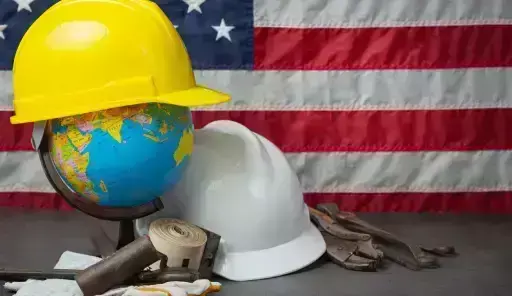U.S. Visa OptionsThe United States remains a global leader in innovation and technology, making it a top destination for skilled professionals—especially engineers to work in the United States.
Whether you're in software development, civil infrastructure, mechanical design, or electrical systems, there are various opportunities in the U.S. for career growth and impact.

For international engineers looking to work experience in the U.S., understanding the available visa type is critical.
The right visa can shape not only your ability to work legally in the country but also your long-term career and immigration prospects. One of the strongest and most flexible options available is the O-1 visa, designed for individuals with extraordinary ability—an ideal fit for highly accomplished engineers with broad qualifications. Factors to Consider When Choosing a U.
S. Work Visa Before exploring different types of visas, it’s important to evaluate your specific situation. Your field of engineering—software, civil, mechanical, or another specialty—may affect which visas are most appropriate.
Nationality also plays a role, as certain visas, such as the TN and E-2, are only available to citizens of specific countries. Educational background is another major consideration. Most work visas require at least a bachelor’s degree, though some, like the O-1 visa, focus more on professional achievements.
Employer sponsorship is also key, as many U.S. visas require a job offer and active petition from a U.
S. employer. Finally, your long-term plans—whether you're pursuing a temporary position or permanent residency—will influence your visa choice.
Some visas, such as the H-1B and O-1, are dual-intent, meaning they allow you to apply for a green card later on.Visa Options for Engineers TN Visa for Canadian and Mexican Engineers The TN visa is a product of the U.S.
-Mexico-Canada Agreement and is available only to citizens of Canada and Mexico. It's a straightforward and fast way for engineers to work in the U.S.
, provided their role falls under one of the approved engineering occupations. This visa can be renewed indefinitely and offers a smooth application process, especially for Canadian professionals. However, it’s not a dual-intent visa, so it’s not ideal for those planning to pursue permanent residency.
H-1B Visa One of the most widely known U.S. work visas, the H-1B is commonly used by engineering professionals across various sectors.
To qualify, you must hold at least a bachelor’s degree and have a job offer from a U.S. employer willing to sponsor your application.
While the H-1B offers benefits like dual intent and eligibility for green card sponsorship, it’s also highly competitive. Each year, applications exceed the cap of 85,000, which includes a 20,000-visa set-aside for individuals with U.S.
master’s degrees. Despite the odds, many engineers still pursue the H-1B, especially those currently studying or working in the U.S.
under F-1 visas and OPT. O-1 Visa for Engineers with Extraordinary Ability The O-1 visa is a non- immigrant visa, specifically tailored for individuals who have reached a high level of achievement in their field. For experts in the STEM field, who have significant achievements like patents, publications, leadership roles, awards, or work featured in the media.
This visa is particularly valuable for high-performing individuals such as startup founders, researchers, or leading software engineers. The O-1 visa is increasingly popular among tech professionals with notable accomplishments. To apply, you must demonstrate national or international recognition and provide substantial documentation—recommendation letters, project overviews, media coverage, and evidence of impact.
The O-1 visa has no annual cap and can be renewed, offering a great deal of flexibility. J-1 Visa for Training and Research Engineers participating in educational, research, or internship programs may qualify for the J-1 visa. This category is commonly used by institutions bringing in international talent for temporary training.
However, some J-1 visas include a two-year home residency requirement, meaning the individual must return to their home country before transitioning to another U.S. visa.
This can be a limiting factor for those seeking long-term employment. E-1 and E-2 Visas Engineers from countries that maintain trade treaties with the U.S.
may be eligible for the E-1 or E-2 visas. These are especially relevant for entrepreneurial engineers involved in trade or investing in U.S.
-based companies. L-1 Visa for Intra-Company Transfers If you work for a multinational company and are being transferred to a U.S.
office, the L-1 visa might be the right fit. It requires that you’ve worked for the company abroad for at least one year in a managerial or specialized knowledge role. The L-1 visa supports dual intent and provides a potential pathway to a green card, making it ideal for engineers already working in global firms.
Green Card Options for Engineers For those aiming to make the U.S. their permanent home, several employment-based green card options exist.
The EB-1A category is available for engineers with extraordinary ability—often a next step for an O-1 visa for engineers holders. The EB-2 category is suitable for those with advanced degrees or exceptional ability, and it includes a National Interest Waiver (NIW) that can waive employer sponsorship. The EB-3 is geared toward skilled workers and professionals with at least a bachelor's degree.
Timelines vary based on visa category and country of origin, but these paths ultimately lead to permanent residency and the freedom to live and work anywhere in the U.S. Choosing the Best Path Forward Selecting the right visa isn’t just about eligibility—it’s about aligning with your goals.
For example, an engineer from India with multiple patents and published research might find the O-1 visa the best way to fast-track their career and future green card through the EB-1A. Meanwhile, a Canadian mechanical engineer might opt for a TN visa for simplicity, later transitioning to an H-1B or green card if their situation evolves. Each journey is unique, and it’s important to map out both short-term opportunities and long-term plans.
How PassRight Can Help Navigating the U.S. immigration system can be overwhelming, especially with complex documentation requirements and tight timelines.
PassRight streamlines U.S. immigration for high-skilled professionals, especially engineers, by combining a seamless document-collection system with seasoned immigration attorneys who build strong, on-time applications.
Whether you’re applying for an O-1 visa or aiming for permanent residency, our team and immigration attorneys can guide you every step of the way..
Entertainment

U.S. Visa Options for Engineers

Explore the best U.S. visa options for engineers, including H-1B, EB-2/NIW, L-1, and O-1 visas. Learn eligibility requirements, application steps, and key tips for a successful process.














